Analysis of the Evolutionary Game of Three Parties in Environmental Information Disclosure in Sustainability Reports of Listed Forestry Companies in China
Abstract
:1. Introduction
2. Literature Review
2.1. Environmental Information Disclosure
2.2. Evolutionary Games
2.3. Environmental Information Disclosure and the Evolutionary Game
3. Game Model
3.1. The Logical Connection between the Subjects of Environmental Information Disclosure of Listed Forestry Companies
3.2. Model Assumptions
3.3. Model Construction
4. Model Analysis
4.1. Evolutionary Game Model Stability Analysis
4.1.1. Stabilization Strategies for the Probability of Choosing “High Quality” Environmental Information Disclosure Strategies for Listed Forestry Companies
- ①
- When , M(z) < 0, , and , then x = 0 has stability, so the stability strategy of forestry listed companies is to choose low-quality environmental information disclosure.
- ②
- When , , and , then has stability, so the stability strategy of listed forestry companies is to choose high-quality environmental information disclosure.
- ③
- When , , and . Then are in a stable state, so it is not possible to determine their stable strategies where the threshold value is
4.1.2. Stabilization Strategy for the Probability of the Government Choosing a “Mandatory” Environmental Information Disclosure Strategy for Listed Forestry Companies
- ①
- When , , and , then y = 1 has stability, so the government’s stability strategy is to force environmental accounting information disclosure.
- ②
- When , , and , then y = 0 has stability, so the government’s stability strategy is voluntary environmental accounting disclosure.
- ③
- When , , , and , then are in a stable state, so it is not possible to determine their stable strategies where the threshold is
4.1.3. Stabilization Strategy for the Probability of the Public Choosing the “Monitoring” Environmental Information Disclosure Strategy
- ①
- When , , and , then has stability, so the stable strategy of the social public is not to supervise the environmental information disclosure of listed forestry companies.
- ②
- When , , and , then has stability, so the stable strategy of the social public is to supervise the environmental information disclosure of listed forestry companies.
- ③
- When , , and , then are in a stable state, so their stable strategies cannot be determined where the threshold is
4.1.4. Three-Party Subject Stabilization Strategy
4.2. Evolutionary Game Simulation Analysis
4.2.1. Simulation of a Three-Group Evolutionary Game with Parameter Changes
4.2.2. The Evolutionary Influence of Different Factors on the Behavioral Strategies of Tripartite Subjects
5. Mechanism Optimization
5.1. Optimize Environmental Information Disclosure Mechanism
5.2. Reward and Punishment Mechanism
5.3. Environmental Information Sharing Mechanism
5.4. Benefit Coordination Mechanism
6. Discussion
7. Conclusions
Author Contributions
Funding
Institutional Review Board Statement
Informed Consent Statement
Data Availability Statement
Conflicts of Interest
References
- Kates, R.W.; Clark, W.C.; Corell, R.; Hall, J.M.; Svedlin, U. Environment and Development. Sustainability Science. Science 2001, 292, 641–642. [Google Scholar] [CrossRef] [PubMed]
- Guo, W.; Jian, X.C.; Guo, J.; Yang, G.X.; Qian, J.M.; Niu, C.Z.; Liang, Q.; Zhang, L.I.; Ang, E.; Botany, I.O. What Is Sustainability Science? Chin. J. Appl. Ecol. 2014, 25, 1. [Google Scholar]
- The International Framework; International Integrated Reporting Council London: London, UK, 2013.
- Min, Y.; Liu, G.; Lu, J.; Liu, J. Recent Development of Integrated Reporting and China’s Corresponding Measures. Account. Res. 2012, 9, 3–8. [Google Scholar]
- Liang, D.; Zhang, H. Environmental Objectives in the 2030 Agenda for Sustainable Development and Its Implications on the World and China in Environmental Governance. China Popul. Resour. Environ. 2016, 26, 8–15. [Google Scholar]
- China Environmental Science Press. China Agenda 21: China’s White Paper on Population, Environment and Development in the 21st Century; China Environmental Science Press: Beijing, China, 1994. [Google Scholar]
- He, S. An Analysis of the New Developments of China’s Environmental Policies since the 18th CPC National Congress. Thinking 2017, 43, 93–100. [Google Scholar]
- The Central Committee of the Communist Party of China the State Council on the Complete and Accurate Implementation of the New Development Concept to Do a Good Job of Carbon Peaking and Carbon Neutral Work. Commun. State Counc. People’s Repub. China 2021, 31, 6.
- Pearce, D.; Putz, F.E.; Vanclay, J.K. Sustainable Forestry in the Tropics: Panacea or Folly? For. Ecol. Manag. 2003, 172, 229–247. [Google Scholar] [CrossRef] [Green Version]
- Liao, B. Empirical Research on Stage and Level Two-Step Measurement for Ecological Civilization in China and Also on the Contribution of Forestry to Ecological Civilization. Ph.D. Thesis, Nanjing Forestry University, Nanjing, China, 2018. [Google Scholar]
- Schaltegger, S.; Wagner, M. Managing Sustainability Performance Measurement and Reporting in an Integrated Manner. Sustainability Accounting as the Link between the Sustainability Balanced Scorecard and Sustainability Reporting; Springer: Berlin/Heidelberg, Germany, 2006. [Google Scholar]
- Jin, D. Research on Listed Company Information Disclosure in Environmental Law. Environ. Sci. Manag. 2011, 36, 7. [Google Scholar]
- Zhu, X. Do Investors Care About the Environmental Information of Listed Companies?—Evidence from the Implementation of the New Environmental Protection Law. Commun. Financ. Account. 2018, 784, 12–16+129. [Google Scholar]
- China Environmental Journalists Association. Evaluation Report on Environmental Responsibility Information Disclosure of Listed Companies in China; China Environment Press: Beijing, China, 2014. [Google Scholar]
- Cormier, D.; Gordon, M.N.I. Examination of Social and Environmental Reporting Strategies. Account. Audit. Account. J. 2001, 14, 587–617. [Google Scholar] [CrossRef]
- Luo, W.; Guo, X.; Zhong, S.; Wang, J. Environmental Information Disclosure Quality, Media Attention and Debt Financing Costs: Evidence from Chinese Heavy Polluting Listed Companies. J. Clean. Prod. 2019, 231, 268–277. [Google Scholar] [CrossRef]
- He, L.; Wu, C.; Yang, X.; Liu, J. Corporate Social Responsibility, Green Credit, and Corporate Performance: An Empirical Analysis Based on the Mining, Power, and Steel Industries of China. Nat. Hazards 2019, 95, 73–89. [Google Scholar] [CrossRef]
- Jenkins, H.; Yakovleva, N. Corporate Social Responsibility in the Mining Industry: Exploring Trends in Social and Environmental Disclosure. J. Clean. Prod. 2006, 14, 271–284. [Google Scholar] [CrossRef]
- Li, Q.; Chen, S.; Zhao, R. The Correlation Analysis of Forestry Industry and Its Development Forecast in China. For. Econ. 2018, 40, 11–15. [Google Scholar]
- Yin, J.; Wang, J.; Min, L. Characteristics and Patterns of Forestry Investment: Perspective of Corporate Social Responsibility Fulfillment. J. Northwest AF Univ. 2017, 17, 152–160. [Google Scholar]
- Shuang, S.; Zhang, W. Forestry Corporate Social Responsibility Framework Study. J. Beijing For. Univ. 2012, 11, 108–113. [Google Scholar]
- Zhang, K.; Shen, J.; Shasha, X.U.; Sun, F. The Evolution Game of Government and Enterprise in Environmental Information Disclosure—The Perspective of Media Supervision. J. Beijing Inst. Technol. 2019, 21, 11–18. [Google Scholar]
- Carlos, M.; Ana, F.; Teresa, E. A Decade of Environmental Accounting Reporting: What We Know? J. Clean. Prod. 2018, 198, 1198–1209. [Google Scholar]
- Liu, M.; Li, Y.; Wu, Q.; Zhang, C. Research on Environmental Accounting Information Disclosure of Listed Forestry Companies in China. Issues Agric. Econ. 2015, 36, 66–72. [Google Scholar]
- Zhao, H. Exploring the Disclosure of Environmental Information of Listed Companies in China—Taking the Paper and Paper Products Industry as an Example. Friends Account. 2018, 23, 71–75. [Google Scholar]
- Zhang, M.; Zeng, H. Research on Information Disclosure of Forestry Listed Companies from the Perspective of Environmental Accounting. China For. Econ. 2020, 1, 117–120. [Google Scholar]
- Wu, G.; Qing, L. Study on the Information Disclosure of Listed Companies’ Environmental Accounting under Low Carbon Economy Perspectibe in China—The Empirical Evidence from Forestry Listed Companies. For. Econ. 2016, 38, 85–89. [Google Scholar]
- Chen, J.; Chen, Y.; Zhang, J. Research on Factors Influencing Environmental Information Disclosure of Forestry Enterprises in China. China Collect. Econ. 2018, 13, 109–112. [Google Scholar]
- Chen, J. Research on Factors Influencing Environmental Information Disclosure of Forestry Enterprises in China. China For. Econ. 2020, 4, 20–23. [Google Scholar] [CrossRef]
- Zeng, S.X.; Xu, X.D.; Dong, Z.Y.; Tam, V. Towards Corporate Environmental Information Disclosure: An Empirical Study in China. J. Clean. Prod. 2010, 18, 1142–1148. [Google Scholar] [CrossRef]
- Liu, X.; Anbumozhi, V. Determinant Factors of Corporate Environmental Information Disclosure: An Empirical Study of Chinese Listed Companies. J. Clean. Prod. 2009, 17, 593–600. [Google Scholar] [CrossRef]
- Martínez-Ferrero, J.; Rodríguez-Ariza, L.; García-Sánchez, I.M.; Cuadrado-Ballesteros, B. Corporate Social Responsibility Disclosure and Information Asymmetry: The Role of Family Ownership. Rev. Manag. Sci. 2018, 12, 885–916. [Google Scholar] [CrossRef]
- Buhr, N.; Freedman, M. A Comparison of Mandated and Voluntary Environmental Disclosure. In Proceedings of the Critical Perspectives on Accounting Conference, Toronto, ON, Canada, 6–7 July 2020. [Google Scholar]
- Doshi, A.; Dowell, G.; Toffel, M.W. How Firms Respond to Mandatory Information Disclosure. Strateg. Manag. J. 2012, 34, 1209–1231. [Google Scholar] [CrossRef] [Green Version]
- Chelli, M.; Durocher, S.; Fortin, A.; Greenwood, M. Normativity in Environmental Reporting: A Comparison of Three Regimes. J. Bus. Ethics 2018, 149, 285–311. [Google Scholar] [CrossRef]
- Mateo-Márquez, A.J.; González-González, J.M.; Zamora-Ramírez, C. The Influence of Countries’ Climate Change-Related Institutional Profile on Voluntary Environmental Disclosures. Bus. Strategy Environ. 2021, 30, 1357–1373. [Google Scholar] [CrossRef]
- Aureli, S.; Gigli, S.; Medei, R.; Supino, E. The Value Relevance of Environmental, Social, and Governance Disclosure: Evidence from Dow Jones Sustainability World Index Listed Companies. Corp. Soc. Responsib. Environ. Manag. 2020, 27, 43–52. [Google Scholar] [CrossRef]
- Wong, R. Corporate Social and Environmental Reporting: A User Perspective. Ph.D. Dissertation, University of Bath, Bath, UK, 2012. [Google Scholar]
- Chauhan, Y.; Kumar, S.B. The Value Relevance of Nonfinancial Disclosure: Evidence from Foreign Equity Investment. J. Multinatl. Financ. Manag. 2019, 52, 100595. [Google Scholar] [CrossRef]
- Zhu, X.; Guan, Y. Analysis of Influencing Factors of Iron and Steel Enterprise Environmental Information Disclosure in China. In Proceedings of the 2013 6th International Conference on Information Management, Innovation Management and Industrial Engineering, Xi’an, China, 23–24 November 2013. [Google Scholar]
- Tang, Y.; Ma, W.; Li, X. Quality of Environmental Information Disclosure, Internal Control Level and Enterprise Value—Empirical Evidence from Listed Companies in Heavy Polluting Indstries. Account. Res. 2021, 69–84. [Google Scholar]
- KoulouKoui, D.; Sant’Anna, M.O.; da Silva Gomes, S.M.; de Oliveira Marinho, M.M.; de Jong, P.; Kiperstok, A.; Torres, E.A. Factors Influencing the Level of Environmental Disclosures in Sustainability Reports: Case of Climate Risk Disclosure by Brazilian Companies. Corp. Soc. Responsib. Environ. Manag. 2019, 26, 791–804. [Google Scholar] [CrossRef]
- Zhou, M.; Bi, C. Study on the Influence of Environmental Performance on Environmental Information Disclosure under Ownership Concentration. Sci. Technol. Dev. 2020, 16, 1078–1085. [Google Scholar]
- Zhu, J.; Jia, T. Impact of Political Connections Upon Environmental Information Disclosure of Listed Companies. J. Wuzhou Univ. 2019, 1, 15–20. [Google Scholar]
- Yang, G.; Du, Y.; Liu, Y. Business Performance, Media Attention and Environmental Information Disclosure. Bus. Manag. J. 2020, 42, 55–72. [Google Scholar]
- Rasmusen, E. Games and Information: An Introduction to Game Theory. Theory Decis. 1990, 29, 161. [Google Scholar]
- Alam, M.; Kabir, K.A.; Tanimoto, J. Based on Mathematical Epidemiology and Evolutionary Game Theory, Which Is More Effective: Quarantine or Isolation Policy? J. Stat. Mech. Theory Exp. 2020, 2020, 033502. [Google Scholar] [CrossRef]
- Amaral, M.A.; de Oliveira, M.M.; Javarone, M.A. An Epidemiological Model with Voluntary Quarantine Strategies Governed by Evolutionary Game Dynamics. Chaos Solitons Fractals 2021, 143, 110616. [Google Scholar] [CrossRef] [PubMed]
- Wölfl, B.; te Rietmole, H.; Salvioli, M.; Kaznatcheev, A.; Thuijsman, F.; Brown, J.S.; Burgering, B.; Staňková, K. The Contribution of Evolutionary Game Theory to Understanding and Treating Cancer. Dyn. Games Appl. 2021, 1–30. [Google Scholar] [CrossRef]
- Yoshida, T.; Mizoguchi, T.; Hatsugai, Y. Chiral Edge Modes in Evolutionary Game Theory: A Kagome Network of Rock-Paper-Scissors Cycles. Phys. Rev. E 2021, 104, 025003. [Google Scholar] [CrossRef] [PubMed]
- Li, X.; Huang, R.; Dai, J.; Li, J.; Shen, Q. Research on the Evolutionary Game of Construction and Demolition Waste (Cdw) Recycling Units’ Green Behavior, Considering Remanufacturing Capability. Int. J. Environ. Res. Public Health 2021, 18, 9268. [Google Scholar] [CrossRef]
- Long, H.; Liu, H.; Li, X.; Chen, L. An Evolutionary Game Theory Study for Construction and Demolition Waste Recycling Considering Green Development Performance under the Chinese Government’s Reward–Penalty Mechanism. Int. J. Environ. Res. Public Health 2020, 17, 6303. [Google Scholar] [CrossRef]
- Hosseini-Motlagh, S.M.; Johari, M.; Zirakpourdehkordi, R. Grain Production Management to Reduce Global Warming Potential under Financial Constraints and Time Value of Money Using Evolutionary Game Theory. Int. J. Prod. Res. 2020, 59, 5108–5129. [Google Scholar] [CrossRef]
- Mahmoudi, R.; Rasti-Barzoki, M. Sustainable Supply Chains under Government Intervention with a Real-World Case Study: An Evolutionary Game Theoretic Approach. Comput. Ind. Eng. 2017, 116, 130–143. [Google Scholar] [CrossRef]
- Xu, L.; Di, Z.; Chen, J.; Shi, J.; Yang, C. Evolutionary Game Analysis on Behavior Strategies of Multiple Stakeholders in Maritime Shore Power System. Ocean. Coast. Manag. 2021, 202, 105508. [Google Scholar] [CrossRef]
- Kabir, K.A.; Chowdhury, A.; Tanimoto, J. An Evolutionary Game Modeling to Assess the Effect of Border Enforcement Measures and Socio-Economic Cost: Export-Importation Epidemic Dynamics. Chaos Solitons Fractals 2021, 146, 110918. [Google Scholar] [CrossRef]
- Hauer, J.F.; Trudnowski, D.J.; Rogers, G.; Mittelstadt, B.; Johnson, J. Evolutionary Games and Population Dynamics. IEEE Comput. Appl. Power 1998, 10, 50–54. [Google Scholar] [CrossRef]
- Sundaresan, R. Game Theory and Mechanism Design. Curr. Sci. 2016, 111, 1104–1105. [Google Scholar]
- Jia, J.Q.; Bu, H.; Yao, S. A Study of Environmental Information Disclosure Supervision Based on Evolutionary Game. East China Econ. Manag. 2014, 28, 145–148. [Google Scholar]
- Zhang, B.; Yan, J. A Study on the Game of Environmental Accounting Disclosure between Government and Enterprises. Friends Account. 2017, 4, 104–106. [Google Scholar]
- Zhao, H.; Zhang, S.; Liu, Y. Analysis of the Factors Influencing Environmental Information Disclosure in the Chemical Industry. Friends Acc. 2018, 5, 23–27. [Google Scholar]
- Peng, X.; Wang, X. Information Game Mechanism and Governance Paths in the Evolution of Environmental Public Crises: The 8-12 Tianjin Port Explosion as an Example. Inn. Mong. Sci. Technol. Econ. 2019, 12, 29–33. [Google Scholar]
- Jun, Q.; Yuan, X. Evolutionary Game Analysis of E Environmental Accounting Information Disclosure Based on Sd Model. Sci. Manag. 2020, 40, 28–38. [Google Scholar]
- Zeng, J. Research on Environmental Information Disclosure of Listed Companies in Polluting Industries under the Background of Environmental Supervision—Based on the Perspective of Evolutionary Game. J. Lanzhou Univ. Financ. Econ. 2021, 37, 97–107. [Google Scholar]
- Wang, Q. Three-Way Game Analysis of Environmental Accounting Information Disclosure of Listed Companies—Based on the Perspective of Stakeholders. Commun. Financ. Account. 2015, 36, 10–13. [Google Scholar]
- Ji, L. To Build up a Quality Characteristics System of Corporate Social Responsibility Information—Based on a Questionnaire of the Information Users. Account. Res. 2013, 1, 50–56. [Google Scholar]
- Ma, Z.; Zhou, Y. Characterization and Stability Methods for Ordinary Differential Equations; Beijing Science Press: Beijing, China, 2001. [Google Scholar]
- Zhang, Y. Evolutionary Game Modeling and Simulation of Social Systems; Beijing Science Press: Beijing China, 2016. [Google Scholar]
- Shen, H.; Peng, Y.; Guo, C. Analysis of the Evolution Game of Construction and Demolition Waste Recycling Behavior Based on Prospect Theory under Environmental Regulation. Int. J. Environ. Res. Public Health 2018, 15, 1518. [Google Scholar] [CrossRef] [Green Version]
- Li, C.; Cao, Y.; Wang, C.; Hao, L. Evolutionary Game Simulation of Tripartite Strategy in E-Commerce Live Streaming under Platform Regulation. Complex Syst. Complex. Sci. 2022, 19, 34–44. [Google Scholar]
- Zeng, Y.; Liu, J. Game Analysis of Environmental Information Disclosure Based on the Relationship between Government and Enterprises. Commun. Financ. Account. 2016, 16, 12–15. [Google Scholar]

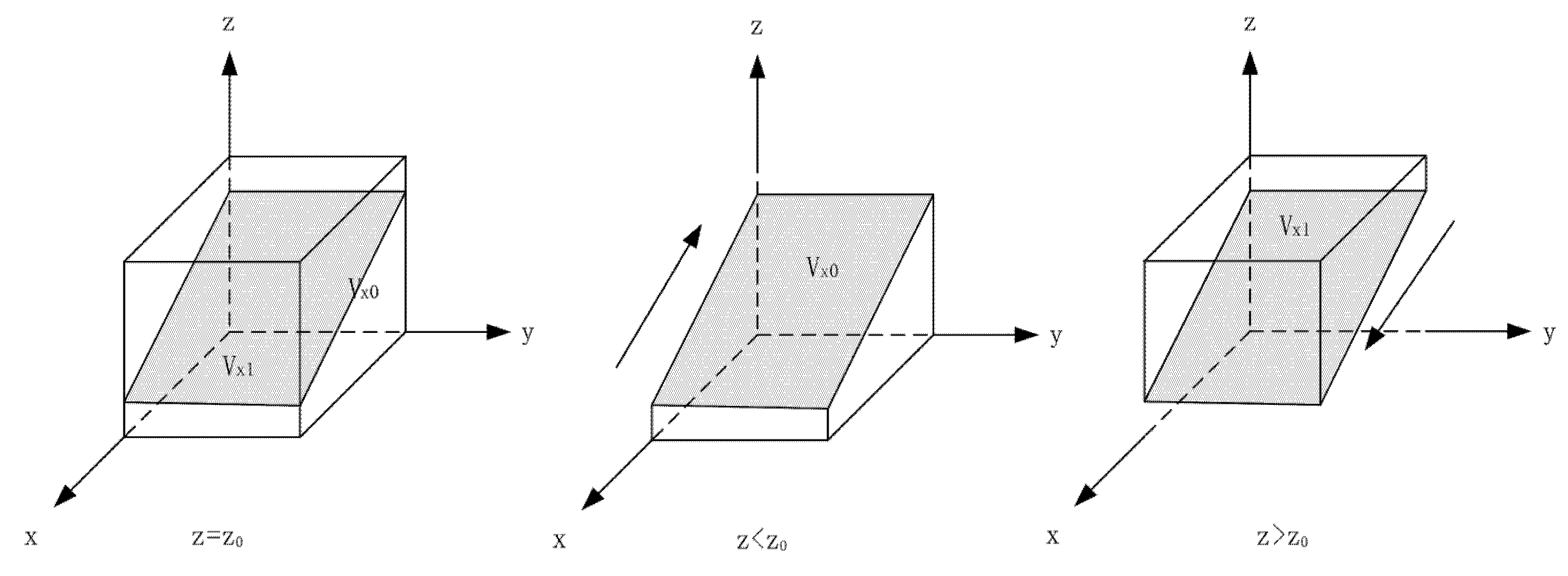
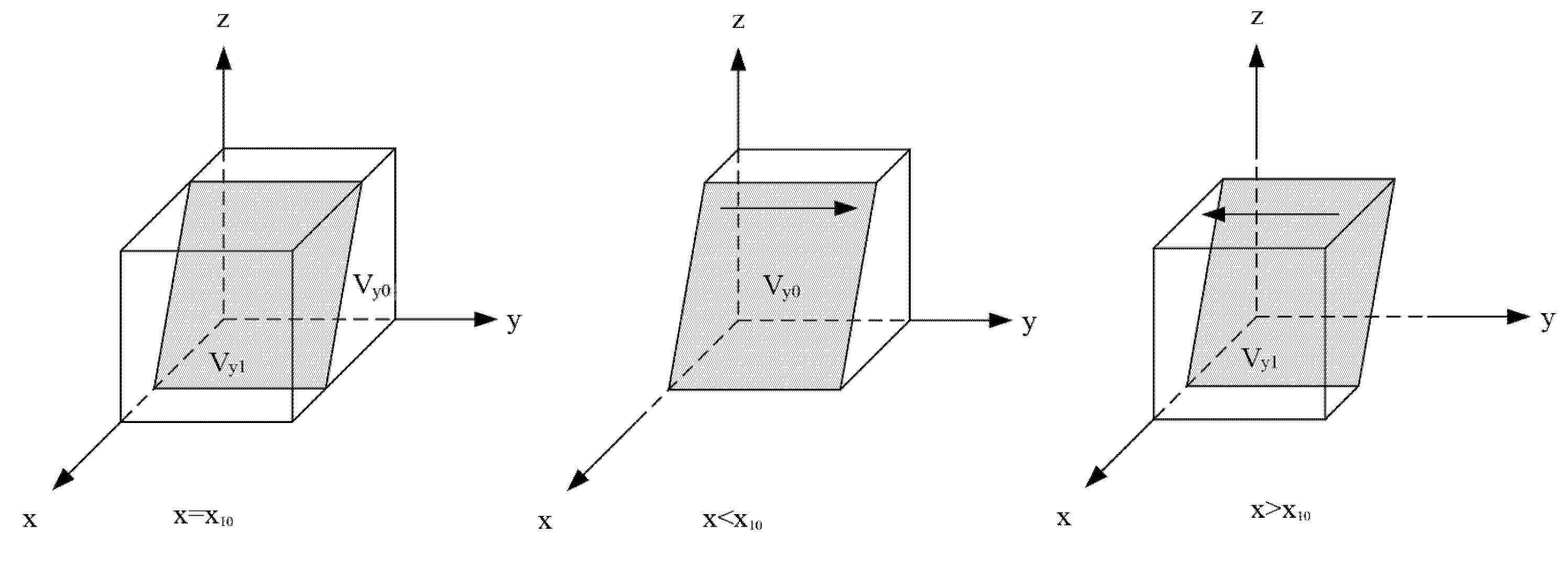
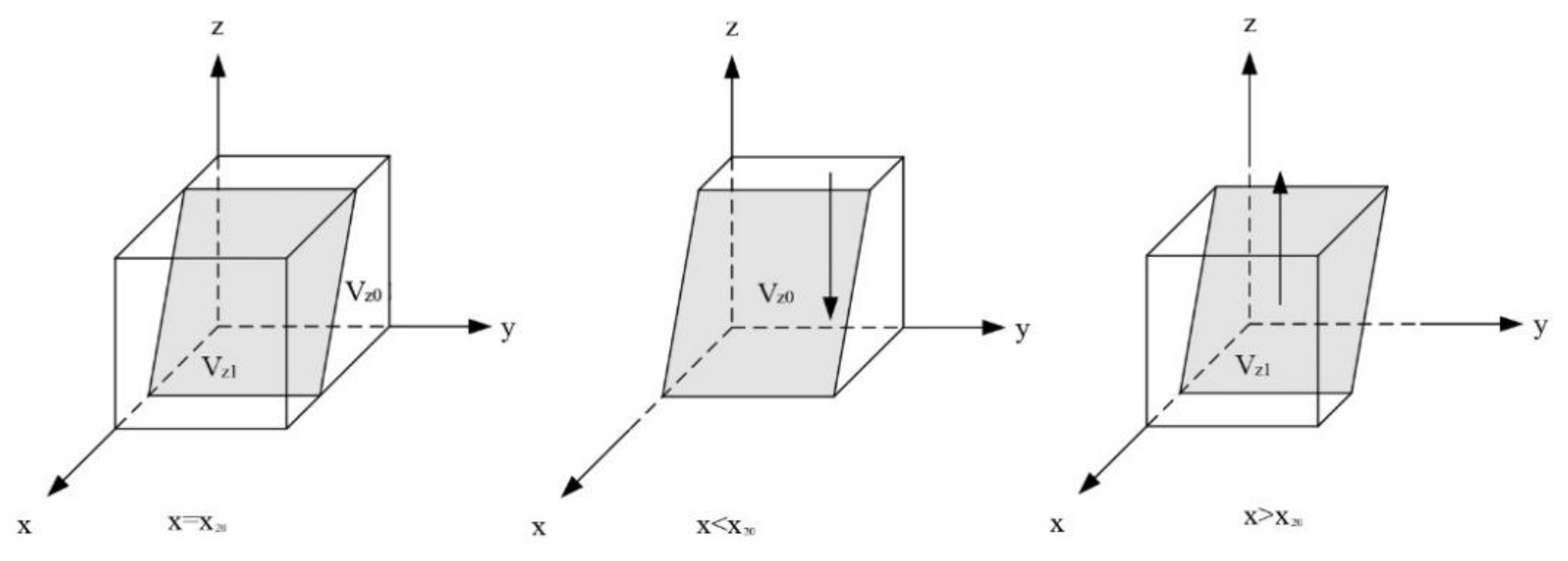
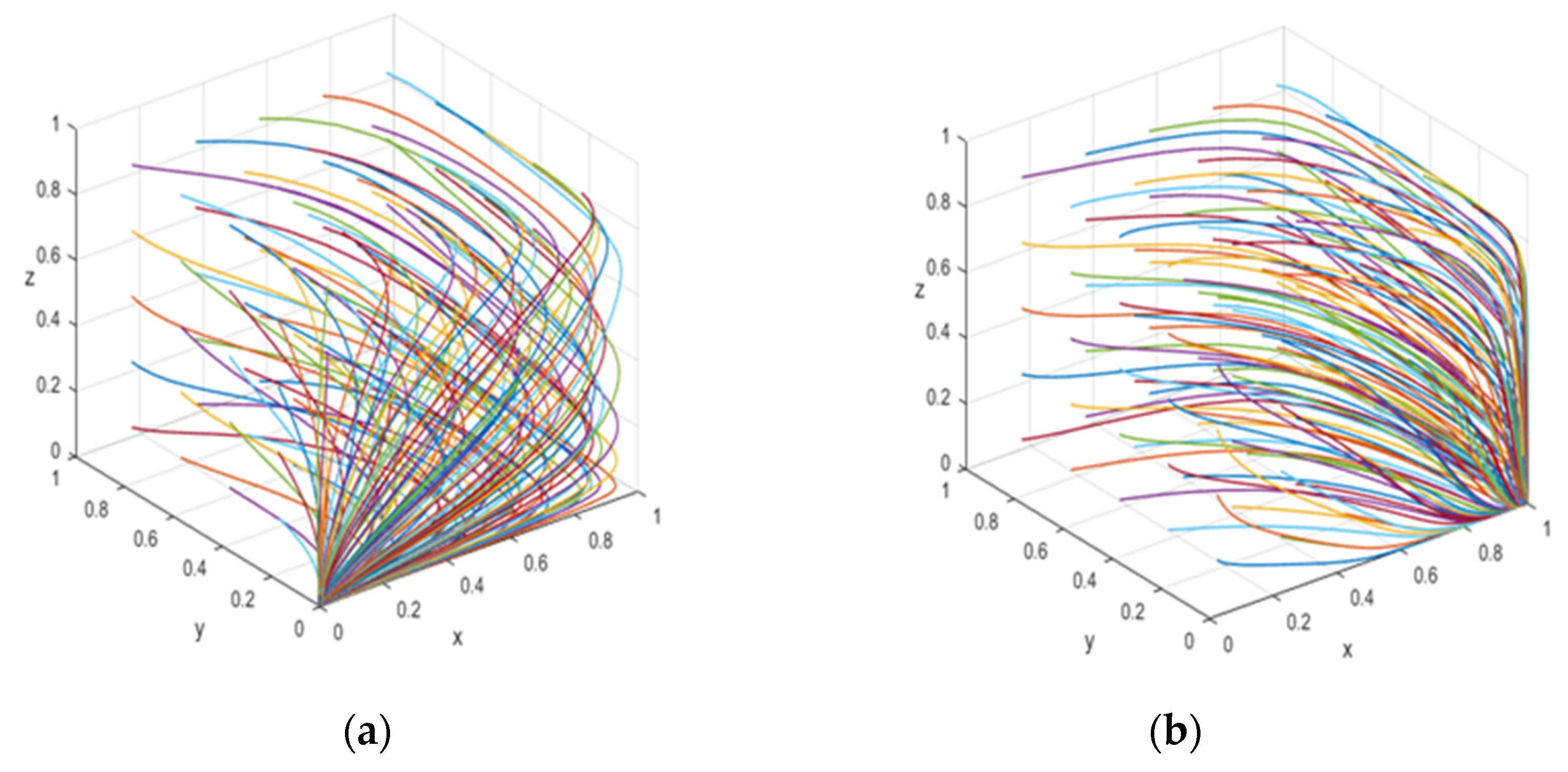

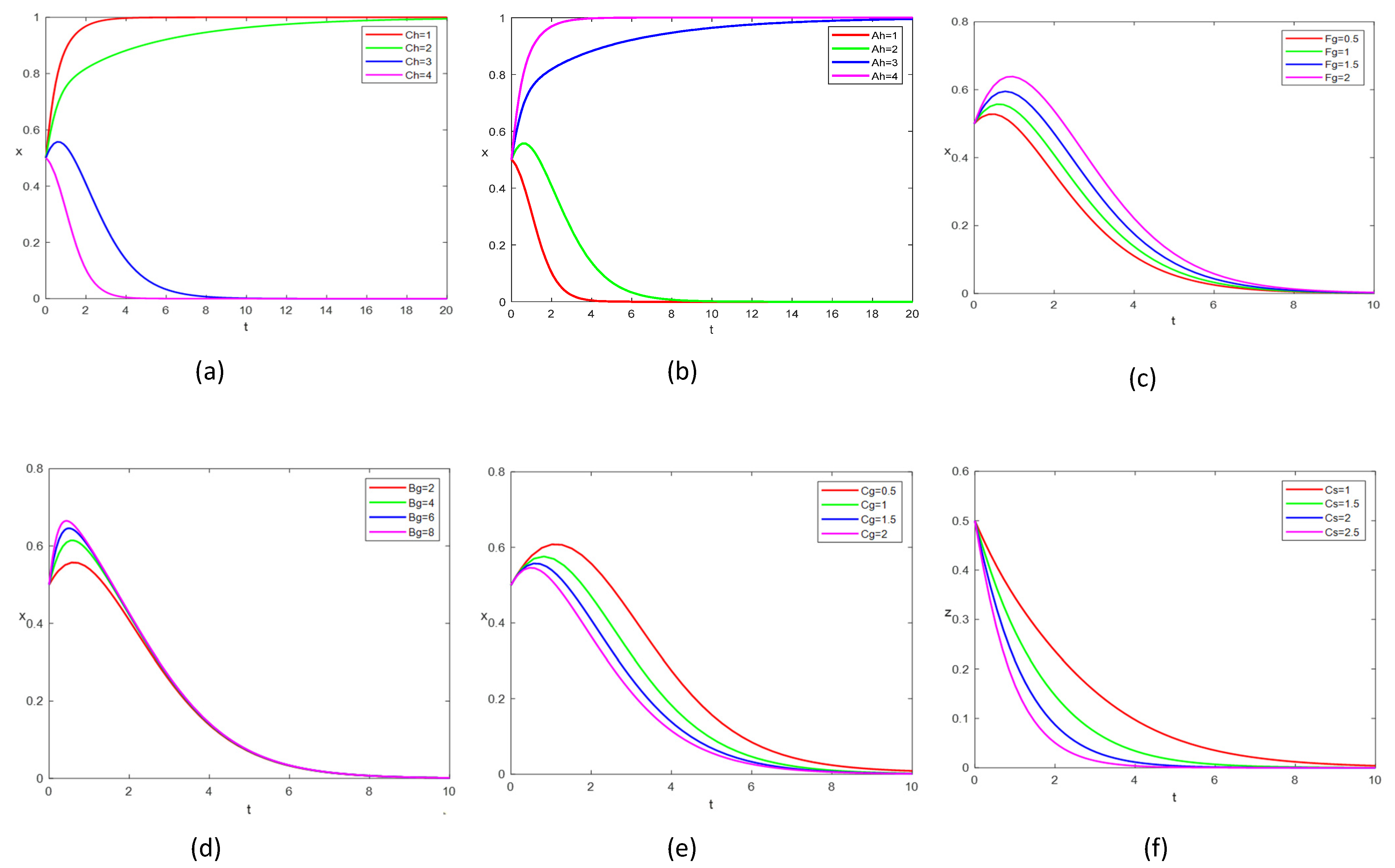
| Research Direction | Main Points |
|---|---|
| Theory | Legitimacy theory [30], |
| Stakeholder theory [31], | |
| Information asymmetry [32], | |
| Voluntary disclosure [33], | |
| Institutional theory [34], etc. | |
| Environmental Information Sources | Integrated reporting [35,36], |
| Sustainability reporting [37], | |
| CSR report [38], | |
| ESG report [39], | |
| Factors influencing environmental information disclosure | Company Scale, etc. |
| Internal factors: Industry sensitivity [31,40,41], financial performance [42], environmental performance [43], quality of environmental information disclosure [41], etc. | |
| External Factors: Political and corporate system [36,44], public opinion monitoring, media coverage [16], public environmental awareness [45], etc. |
| Parameters | Significance |
|---|---|
| x | The proportion of listed forestry companies choosing high-quality environmental information disclosure |
| y | The proportion of governments choosing to mandate environmental accounting disclosure |
| z | The proportion of society choosing to monitor environmental information disclosure of listed forestry companies |
| Ch | Costs of forestry listed companies in selecting high-quality environmental information disclosure |
| Ce | Costs of environmental management for listed forestry companies |
| Cl | Disclosure of the cost of choosing low-quality environmental information disclosure by listed forestry companies |
| Ge | Benefits obtained from the disclosure of environmental information by listed forestry companies |
| Ah | The credibility of listed forestry companies when high-quality environmental information is disclosed |
| Al | The credibility of listed forestry companies when low-quality environmental information is disclosed |
| Es | Benefits to the public |
| Eg | Government gains benefits |
| Cg | Costs of mandatory environmental information disclosure by government departments to listed forestry companies |
| Fg | Government fines for listed forestry companies that provide no or low-quality environmental information disclosure |
| Bg | Government incentive payments for listed forestry companies that actively engage in high-quality environmental information disclosure |
| Cv | The cost that government regulators need to pay to verify the authenticity of social public monitoring |
| CS | The cost of social public monitoring |
| De | Forestry listed companies need to bear the loss of public supervision of the authenticity of the community |
| δ | Probability of truthfulness of social public supervision of environmental information disclosure of listed forestry companies |
| Strategy Profile | Forestry Listed Companies, Government Regulators, The Public |
|---|---|
| (High-quality, Mandatory, Supervision) | (Ge − Ch − Ce + Ah + Bg, Eg − Cg − Bg, Es − Cs) |
| (High-quality, Mandatory, No Supervision) | (Ge − Ch − Ce + Ah + Bg, Eg − Cg − Bg, Es) |
| (High-quality, Voluntary, Supervision) | (Ge − Ch − Ce + Ah − (1 − δ)De, Eg − (1 − δ)Cv, Es − (1 − δ)Cs) |
| (High-quality, voluntary, No supervised) | (Ge − Ch − Ce + Ah, Eg, Es) |
| (Low-quality, Mandatory, Supervision) | (Ge − Cl − Ce + Al − Fg, Eg + Fg − Cg, Es − Cs) |
| (Low-quality, Mandatory, No Supervision) | (Ge − Cl − Ce + Al − Fg, Eg + Fg − Cg, Es) |
| (Low-quality, Voluntary, Supervision) | (Ge − Cl − Ce + Al − δDe, Eg − δCv, Es − δCs) |
| (Low-quality, Voluntary, No Supervision) | (Ge − Cl − Ce + Al, Eg, Es) |
| Equilibrium Point | Characteristic Root | Stability Condition | Stability | ||
|---|---|---|---|---|---|
| λ1 | λ2 | λ3 | |||
| E1 (0,0,0) | Ah − Al − Ch + Cl | Fg − Cg | −δCs | Ah −
Al <
Ch −
Cl Fg < Cg | Asymptotic stability point |
| E2 (0,0,1) | Ah − Al − Ch + Cl + (2δ − 1)De | Fg − Cg + δCv | δCs | Positive characteristic root | Unstable point |
| E3 (0,1,1) | Ah − Al − Ch + Cl + Bg + Fg | Cg − Fg − δCv | Cs | Positive characteristic root | Unstable point |
| E4 (1,0,0) | −Ah + Al + Ch − Cl | −Cg − Bg | −(1 − δ)Cs | Ch − Cl < Ah − Al | Asymptotic stability point |
| E5 (0,1,0) | Ah − Al − Ch + Cl + Bg + Fg | Cg − Fg | −Cs | Positive characteristic root | Unstable point |
| E6 (1,0,1) | Al − Ah + Ch − Cl − (2δ − 1)De | (1 − δ)Cv − Cg − Bg | (1 − δ)Cs | Positive characteristic root | Unstable point |
| E7 (1,1,0) | Al − Ah + Ch − Cl − Bg − Fg | Cg + Bg | −Cs | Positive characteristic root | Unstable point |
| E8 (1,1,1) | Al − Ah + Ch − Cl − Bg − Fg | Cg + Bg − (1 − δ)Cv | Cs | Positive characteristic root | Unstable point |
Publisher’s Note: MDPI stays neutral with regard to jurisdictional claims in published maps and institutional affiliations. |
© 2022 by the authors. Licensee MDPI, Basel, Switzerland. This article is an open access article distributed under the terms and conditions of the Creative Commons Attribution (CC BY) license (https://creativecommons.org/licenses/by/4.0/).
Share and Cite
Lu, B.; Yue, S. Analysis of the Evolutionary Game of Three Parties in Environmental Information Disclosure in Sustainability Reports of Listed Forestry Companies in China. Sustainability 2022, 14, 2871. https://doi.org/10.3390/su14052871
Lu B, Yue S. Analysis of the Evolutionary Game of Three Parties in Environmental Information Disclosure in Sustainability Reports of Listed Forestry Companies in China. Sustainability. 2022; 14(5):2871. https://doi.org/10.3390/su14052871
Chicago/Turabian StyleLu, Bowen, and Shangzhi Yue. 2022. "Analysis of the Evolutionary Game of Three Parties in Environmental Information Disclosure in Sustainability Reports of Listed Forestry Companies in China" Sustainability 14, no. 5: 2871. https://doi.org/10.3390/su14052871
APA StyleLu, B., & Yue, S. (2022). Analysis of the Evolutionary Game of Three Parties in Environmental Information Disclosure in Sustainability Reports of Listed Forestry Companies in China. Sustainability, 14(5), 2871. https://doi.org/10.3390/su14052871






